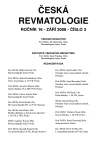Diffuse idiopathic skeletal hyperostosis (DISH) in old age, exceptionally deforming disease
Authors:
A. Pavelková
Authors‘ workplace:
Revmatologický ústav Praha
Published in:
Čes. Revmatol., 16, 2008, No. 3, p. 119-123.
Category:
Case Report
Overview
Diffuse idiopathic skeletal hyperostosis (DISH) is a noninflammatory skeletal disease characterized by hyperostosis in the area of both axial skeleton and periphery. It develops after the 40th year of age and manifests most frequently in the middle and higher age. Its association with type 2 diabetes mellitus and other metabolic disorders, hyperuricemia and metabolic disorder of lipids, has been known for some years already, although the relationship is not completely clear yet. This disease is often linked with common vertebrogenic ailment, which corresponds with its intensity to degenerative spine disease, however, it can also lead to a severe deforming involvement with great clinical distress. The manifestations of the disease are clinically and objectively close to ankylosing spondylitis.
Key words:
DISH, hyperostosis, diabetes mellitus, insulin resistence
Sources
1. Smythe H, Littlejohn G. Diffuse idiopathic skeletal hyperostosis. In: Klippel JH, Dieppe PQ: Rheumatology, St Louis, Mosby 1994; 9: 1–9.
2. Littlejohn GO, Urowitz MB. Peripheral enthesopathy in difuse idiopathic skeletal hyperostosis (DISH): a radiological study. J Rheumatol 1982; 9: 568–72.
3. Resnick D, Saul SR, Robins JM. Difuse idiopathic skeletal hyperostosis (DISH): Forestier’s disease with extra spinal manifestations. Radiology 1975; 115: 513–24.
4. Jalkunen H, Heinonen OP, Knekt P, et al. The epidemiology of hyperostosis of the spine together with its symptoms and related mortality in general population. Scand J Rheumatol 1973; 40: 581–91.
5. Littlejohn GO. Insulin and new bone formation in difuse idiopathic skeletal hyperostosis. Clin Rheumatol 1985; 4: 294–300.
6. Littlejohn G. DISH In: Hochberg M, et al. Rheumatology, Mosby 2003; s. 1863.
7. Littlejohn GO, Smythe HA. Marked Hyperinsulinemia after Glucose Challenge in Patients with Diffuse Idiopathic Skeletal Hyperostosis. J Rheumatol 1981; 8: 965–8.
8. Bluestone R, Bywaters EG, Hartoo M, et al. Acromegalic arthropathy. Ann Rheum Dis1971; 30: 243–50.
9. BošákV, Žlnay D, Navrátil J, et al. Imunogenetické aspekty při ankylozujúcej hyperostóze. Rheumatologia 1988; 2: 8–14.
10. Pavelková A, Havelka S, Veselá M, Hulejová H, Justová V. Metabolické kostní ukazatele u difuzní idiopatické skeletální hyperostózy. Rheumatologia 2001; 15: 161–6.
11. Fortin PR, Mata S, Joseph L, et al. Is difuse idiopathic skeletal hyperostosis a distinct entity? A controlled study. Arthritis Rheum 1995; 38 (suppl): 657 (abstract).
12. Kamila M, Farada A, Mizuno M, Iwata H, Yamada Y. Association between a polymorpism of the transforming factor-beta 1 gene susceptibility to ossification of the posterior longitudinal ligament in Japanese patiens. Spine 2001; 26: 1264–6.
Labels
Dermatology & STDs Paediatric rheumatology RheumatologyArticle was published in
Czech Rheumatology

2008 Issue 3
Most read in this issue
- Rhizarthrosis of carpometacarpal (CMC) joint of a thumb
- Diffuse idiopathic skeletal hyperostosis (DISH) in old age, exceptionally deforming disease
- Recent findings in the pathogenesis of post-chlamydial reactive arthritis
- Cricopharyngeal achalasia in myositis
